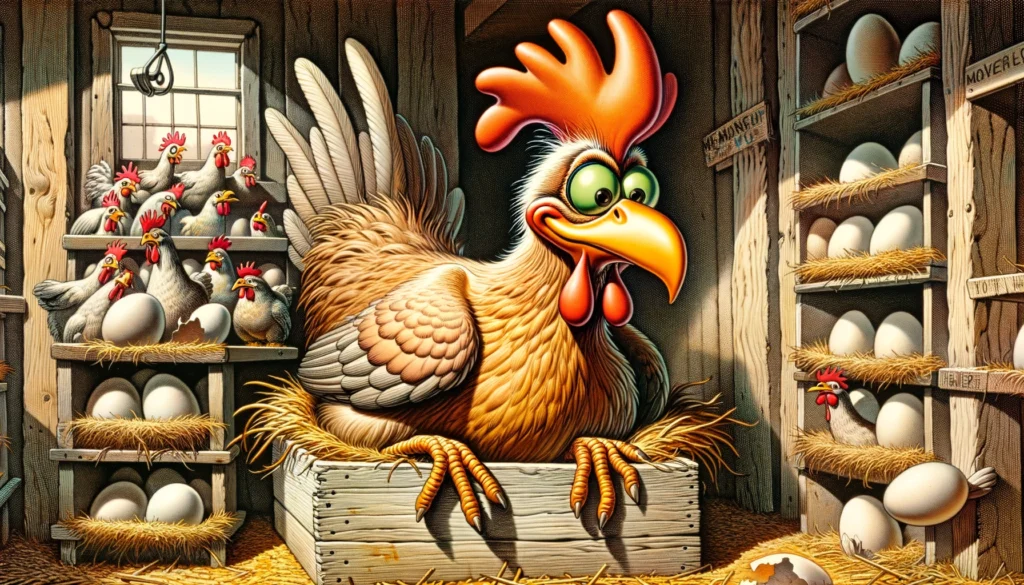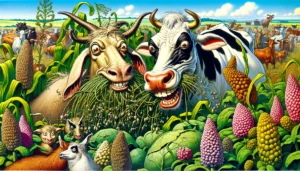
Layer Chicken A detailed close up illustration in the exaggerated satirical style of Mad Magazine focusing on a female layer chicken from the previous scene. The 1.webp.webp
Layer
Definition:
A layer refers to a female chicken, specifically of the species Gallus gallus domesticus, raised and managed in agricultural settings primarily for egg production. Layers are selectively bred for high egg-laying capabilities, efficient feed conversion, and consistent egg quality traits, making them suitable for commercial egg production, egg farming, and egg industry operations.
Description:
Layers play a crucial role in egg production, supplying fresh, nutritious eggs for human consumption, culinary purposes, and food processing applications. Layer production involves raising chickens under controlled conditions, optimizing nutrition, housing, and management practices to maximize egg production, egg quality, and production efficiency.
Fall off the barn roof and busted your keister? Life on the farm or ranch can be tough on the bum. Need a break? Laugh it off at FarmerCowboy.com, the #1 farm humor site. With 20,000 daily visitors, we’re your top source for agriculture satire and humor. Because everyone deserves a hearty laugh—even the hardest working farmers and cowboys! Join us and turn those long days into fun tales at FarmerCowboy.com.
Characteristics of Layers:
Layers possess various characteristics, including:
- Egg-Laying Abilities: Layers are prolific egg layers, capable of producing a consistent supply of eggs throughout their laying cycles, with variations in egg size, color, shell quality, and internal qualities, influenced by factors such as breed genetics, nutrition, age, and environmental conditions.
- Feed Efficiency: Layers are efficient converters of feed into eggs, with high feed conversion ratios, indicating the amount of feed required to produce a unit of egg mass, optimizing feed utilization, nutrient absorption, and energy metabolism for egg formation and shell deposition.
- Egg Quality: Layers produce eggs with desirable quality attributes, such as shell integrity, yolk color, albumen consistency, and internal qualities, meeting consumer expectations, market standards, and regulatory requirements for fresh, safe, and nutritious eggs in retail markets and foodservice establishments.
- Behavior: Layers exhibit nesting instincts, egg-laying behaviors, and social interactions within layer flocks or groups, engaging in activities such as nest building, egg laying, dust bathing, or flock bonding, demonstrating natural behaviors, communication signals, and social hierarchies in chicken communities.
Uses of Layers:
Layers serve various purposes in agriculture and food industries, including:
- Egg Production: Layers are raised primarily for egg production, supplying table eggs, such as white eggs, brown eggs, or specialty eggs, for human consumption, culinary applications, or food manufacturing, providing essential nutrients, proteins, and vitamins for consumers, households, or foodservice establishments.
- Egg Processing: Layer eggs are processed into various egg products, such as liquid eggs, egg powders, egg pasteurized products, or egg-based ingredients, for food manufacturing, bakery goods, or foodservice applications, contributing to product formulations, ingredient sourcing, and culinary innovations in egg-based foods.
- Export Markets: Layer eggs and egg products are exported to international markets, catering to global demand for high-quality eggs, specialty eggs, or value-added egg products, contributing to trade agreements, economic exchanges, and agricultural exports in egg-producing regions.
Conclusion:
Layers are essential components of egg production, supplying fresh, nutritious eggs for human consumption, culinary purposes, and food industries worldwide. By implementing proper husbandry practices, nutrition programs, and health management protocols, farmers, producers, and egg industry stakeholders can ensure the welfare, productivity, and sustainability of layer populations for egg production and agricultural sustainability.
References:
- FAO (Food and Agriculture Organization of the United Nations). (2020). Poultry Sector Brief: Global Layer Production. Food and Agriculture Organization.
- Roland, D. A. (2017). Egg and Egg Product Handling, Processing, and Marketing (2nd ed.). CRC Press.
Originally posted 2014-04-07 14:00:02.
Originally posted 2024-07-02 04:11:45.
Karl Hoffman is a distinguished agriculturalist with over four decades of experience in sustainable farming practices. He holds a Ph.D. in Agronomy from Cornell University and has made significant contributions as a professor at Iowa State University. Hoffman’s groundbreaking research on integrated pest management and soil health has revolutionized modern agriculture. As a respected farm journalist, his column “Field Notes with Karl Hoffman” and his blog “The Modern Farmer” provide insightful, practical advice to a global audience. Hoffman’s work with the USDA and the United Nations FAO has enhanced food security worldwide. His awards include the USDA’s Distinguished Service Award and the World Food Prize, reflecting his profound impact on agriculture and sustainability.





